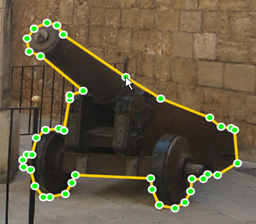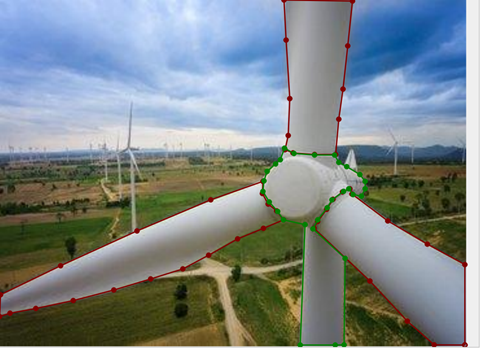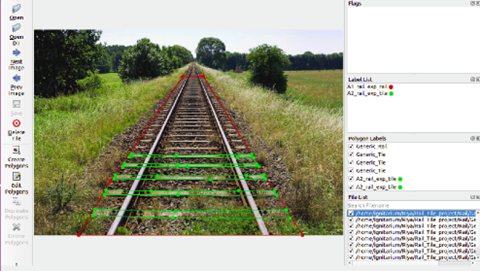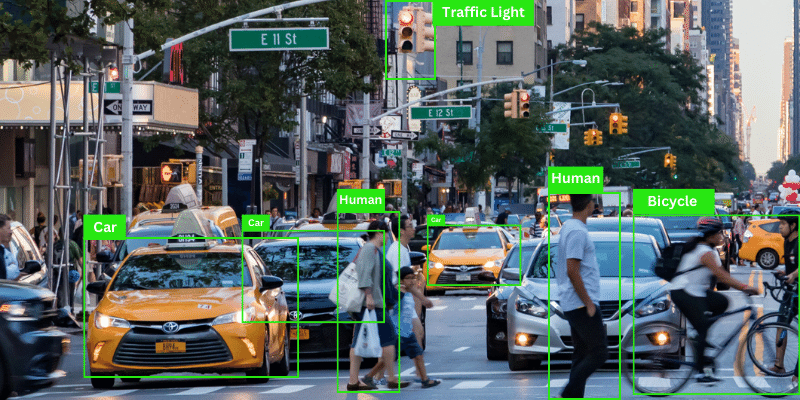- Riya, Stephani and Syed
- January 11, 2023
Data Annotation For Video AI Projects
1. Introduction
Data annotation is the process of adding tags or labels to raw data such as images, videos, text, and audio. These tags form a representation of what class of objects the data belongs to and helps a machine learning model learn to identify that particular class of objects when encountered in data without a tag. Data annotation (also known as data labeling) plays a very important role in ML (Machine Learning) and AI-based projects.
Different kinds of input data call for different types of labeling approaches. For example, for speech labeling, samples are ‘cut’ into segments that might represent noise or silence or the temporal boundaries of specific spoken keywords. For text labeling for (say) an NLP (Natural Language Processing) application, a specific word or phrase segment would be labelled and segregated into different classes. For a gesture control application, numerical data (eg. X, Y, Z axis data from an accelerometer or a gyroscope) would be labelled in their frequency domain to identify specific signatures associated with an action in 3D space.
In this article, we consider still image and moving video as our input data. We describe various kinds of image label types, standard tools, custom extensions for improving labeling efficiency, integration with standard AI project infrastructure and well as different labeling workflows.
2. Types Of Image Data Annotations
Various types of data annotation methods are adopted based on the specific detection or classification problem that is being addressed. Various ML and DL (Deep Learning) algorithms require annotations to be in different formats to allow object features to be recognized and extracted efficiently during the inference process. In order to get the best possible results, it is crucial to use the proper type of annotation.
Some of the common image annotation types are the following:
2.1 Bounding Boxes
Bounding boxes are generally used as labels for detector class of AI applications, allowing high accuracy object recognition and perception models to be built. From the ubiquitous cat/dog localization in an image to self-driving vehicles, these relatively simple class of annotations are highly relevant in many practical applications.

2.2 Polygon Annotations
Polygon annotation is a multipoint annotation technique employed to draw shapes, curves and various angles. They mark pixel level category annotations in an image.

2.3 Points Annotations
Key Points are used to detect small objects and shape variations by creating dots across the image. This helps with detecting and labeling facial / skeletal features, expressions, emotions, human body parts, poses and landmarks.

2.4 Line Annotation
Lines and splines are used to mark the boundaries of a region of interest within an image that contains the target object. This is often used when regions of interest containing target objects are too thin or too small for bounding boxes.

3. Data Annotation Tools
A vast variety of annotation tools are used by the industry – ranging from open source to proprietary. Listed below are some of the popular image annotation tools:
LabelImg
LabelImg is a graphical image annotation tool allowing labeling of object bounding boxes in images.
Link:https://github.com/heartexlabs/labelImg
Labelme
Labelme is an open-source annotation tool. It was written in python to support manual polygonal annotation of objects for classification and segmentation. Labelme allows the creation of various shapes including polygon, circles, rectangles, lines, line strips, points etc.
Link:https://github.com/wkentaro/labelme
MakeSense
Makesense is a free-to-use online tool for labeling images. It is used for small computer vision / deep learning projects. Generated labels can be downloaded in multiple formats.
Link: https://www.makesense.ai/
CVAT
CVAT (Computer Vison Annotation Tool) is a popular web based open-source image and video annotation tool developed by Intel. CVAT is used for labeling data for image classification, object detection, image segmentation. CVAT offers different types of shapes for annotation such as rectangle, polygon, points, ellipse, polyline, cuboid. It supports multiple annotation formats: label VOC XML, label COCO JSON, label YOLO annotations etc.
Link:https://opencv.github.io/cvat/docs/administration/basics/installation/
SuperAnnotate
SuperAnnotate is an end-to-end platform to annotate image, video and text. This advanced tool offers different types of shapes for annotation such as bounding box, polygon/polyline, ellipse, keypoint, cuboid. This tool enables the annotation of images and videos with high accuracy.
Link:https://www.superannotate.com/annotation-tool
4. Data Annotation Tool Enhancements
Even though a plethora of highly capable open-source annotation tools exist, most of them suffer from lack of specific features that are practically required for the execution of large and complex AI projects. At Ignitarium, we have developed custom extensions to the above tools to incorporate key features such as the following:
- Client-server based multiple labeler support wherein single images or batches of images can be served (with workflow tracking) to remotely located, individual annotation engineers in a team
- Support for contour hierarchies
- Improved support for precise semantic labelling
- Enforcement of parent-child relationships
- Ability to add custom image label tags
- Better integration into source code repositories (eg. Git)

5. Image Labeling Workflows
AI teams employ various strategies to efficiently deal with the vast amount of data that needs to be labelled and managed as part of complex projects.
5.1 Manual Labeling
The tried and tested method employed by most teams is to perform manual dataset labeling leveraging natural intelligence of humans in recognizing patterns even within poor quality images.
Internal Labeling
This is when experts within the company label datasets. It is also known as in-house labelling. Labelers within an AI team usually know what is specifically needed for a particular type of model. This is usually the highest quality labelling approach with more accurate annotations. Data resides on systems that adhere to a company’s IT policies and hence the risk of data leakage is minimal.
External Labeling
In this method, also known as out-sourced/crowd-sourced labeling, annotation tasks are given to external labelers or freelance workforce outside the company. The difference between crowd-sourced and out-sourced labeling is that crowd-based labeling assigns tasks to a group of unorganized workers, whereas outsourcing involves an organized workforce – usually a company that specifically focuses on data annotation as a business.
At Ignitarium, our strategy has been largely the following:
- For PoC level projects or where complex, high precision annotations are called for, we use our internal expert-level labeling team
- For high data volume projects, our expert annotators will generate sample labels for complex scenarios, provide these as reference to the workforce of a trusted annotation partner company and then participate in the review of critical labels and / or randomly selected labels, as a quality assurance measure
5.2 Human-in-the-loop training and Auto-Labelling
The Human-in-the-loop workflow judiciously blends both human and machine intelligence to generate AI models faster. Generally, the process starts with a human labeling the data and then this being used to train a model. As the model matures, this model is used to generate more labels automatically. These generated labels are inspected, validated, or corrected by humans, thus iteratively increasing the accuracy and volume of the labels as well as the quality of the model used for auto-labeling. The workflow has to be carefully implemented with the AI model team and the annotation team collaborating closely to achieve faster convergence.

At Ignitarium, we leverage our rich set of model libraries to quickly incorporate model-based auto-labeling into the majority of our AI projects.
6. Application Examples
We have executed 100+ still image and video-based AI projects across a host of application domains using open source and custom-enhanced labeling tools. A few sample use cases from our TYQ-i(TM): Deep Learning based Defect Detection Platform are shown below:

Figure 7 shows the wind turbine blade contours and the super-structure being labelled. This will be used as the first level (parent) hierarchy for subsequent labeling of defects (child) within the body of the blade or the super-structure.

Figure 8 shows our customized labeling tool being used to annotate rail tracks and wooden ties. Next level labels will include finer artefacts like cracks, plates, spikes etc.
7. Challenges In Data Annotation
The most common challenges in data annotation are:
- Time consuming: Manual data labeling is highly time-consuming and can prove to be very expensive based on the data volume.
- Chances of human error: Quality refers to how consistently accurate an entire dataset is. The problem of incorrect data labels affects the quality of data and leads to inaccurate models.
- Human bias: The interpretation of what an artifact (and eventually the corresponding label) actually is, can vary between different labelers. Timely reviews by expert labelers and constant sync-up with the model teams can reduce this bias.
8. Conclusion
It can be safely said that the fate of an AI / ML project is dependent heavily on the quality of annotated data. The choice of annotation tool, advanced multi-labeler collaboration infrastructure, a smart mix of auto-labeling & manual annotation workflows and a small expert labeler oversight team are usually the difference between a highly quality AI model or an average one.
































